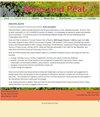圆叶芥菜的生物学、生态学、利用、保护与栽培综述。
IF 1.5
4区 环境科学与生态学
Q4 ENVIRONMENTAL SCIENCES
引用次数: 20
摘要
Drosera rotundifolia是一种多年生食虫草本植物,生长在开阔、潮湿、少营养的生境,如酸性沼泽和贫瘠的沼泽,特别生长在以sphagam为主的群落中。自中世纪以来,人们从自然栖息地采集这种植物,并将其用作治疗咳嗽和肺部疾病的药物。由于Drosera栖息地的大量减少,自20世纪80年代以来,这种植物在大多数欧洲国家受到保护,这意味着野生的圆叶菊已经无法用于制药工业。持续的需求刺激了几个欧洲国家对Drosera种植的研究。这些研究表明,Drosera的培养是耗时的,而且(尚未)具有成本效益,因此需要开发培养方法。本文综述了圆叶Drosera的形态、分布、生态和繁殖;概述其商业用途及自然保育规定;并介绍了国内外对其繁殖栽培的研究情况。本文章由计算机程序翻译,如有差异,请以英文原文为准。
Biology, ecology, use, conservation and cultivation of round-leaved sundew (Drosera rotundifolia L.): a review.
Drosera rotundifolia is a perennial insectivorous herb which occupies open, wet, oligotrophic habitats such as acidic bogs and poor fens, and specifically grows in Sphagnum-dominated communities. Since mediaeval times the species has been collected from natural habitats and used as a remedy for coughs and pulmonary diseases. Due to the substantial decline of Drosera habitat, the plant has been protected in most European countries since the 1980s, which means that wild D. rotundifolia has become unavailable to the pharmaceutical industry. The persistent demand has stimulated research into the cultivation of Drosera in several European countries. These studies have shown that Drosera cultivation is time-consuming and not (yet) cost-effective, and there is a need for the development of cultivation methods. This article reviews the morphology, distribution, ecology and reproduction of Drosera rotundifolia; outlines its commercial use and nature conservation requirements; and describes previous research on its propagation and cultivation.
求助全文
通过发布文献求助,成功后即可免费获取论文全文。
去求助
来源期刊

Mires and Peat
ENVIRONMENTAL SCIENCES-
CiteScore
2.30
自引率
16.70%
发文量
0
审稿时长
33 weeks
期刊介绍:
Mires and Peat is a peer-reviewed internet journal focusing specifically on mires, peatlands and peat. As a truly “free-to-users” publication (i.e. NO CHARGES to authors OR readers), it is immediately accessible to readers and potential authors worldwide. It is published jointly by the International Peatland Society (IPS) and the International Mire Conservation Group (IMCG).
Mires and Peat is indexed by Thomson Reuters Web of Science (2017 Impact Factors: 1.326 [two-year] and 1.638 [five-year]), Elsevier Scopus, EBSCO Environment Complete, CABI Abstracts, CSA Proquest (including their Aquatic Science and Fisheries Abstracts ASFA, Ecology, Entomology, Animal Behavior, Aqualine and Pollution databases) and Directory of Open Access Journals (DOAJ). Mires and Peat also participates in the CABI Full Text Repository, and subscribes to the Portico E-journal Preservation Service (LTPA).
Mires and Peat publishes high-quality research papers on all aspects of peatland science, technology and wise use, including:
ecology, hydrology, survey, inventory, classification, functions and values of mires and peatlands;
scientific, economic and human aspects of the management of peatlands for agriculture, forestry, nature conservation, environmental protection, peat extraction, industrial development and other purposes;
biological, physical and chemical characteristics of peat; and
climate change and peatlands.
Short communications and review articles on these and related topics will also be considered; and suggestions for special issues of the Journal based on the proceedings of conferences, seminars, symposia and workshops will be welcomed. The submission of material by authors and from countries whose work would otherwise be inaccessible to the international community is particularly encouraged.
 求助内容:
求助内容: 应助结果提醒方式:
应助结果提醒方式:


